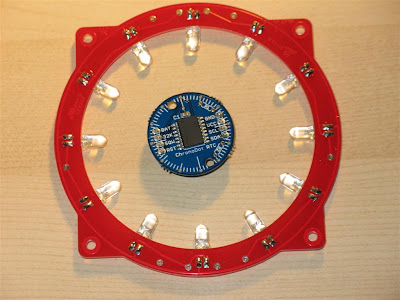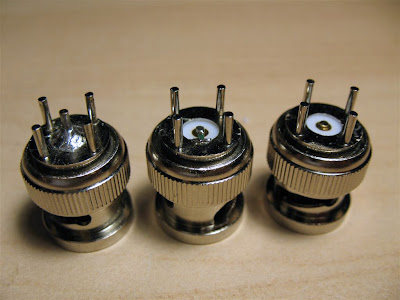I ordered the kit from Evil Mad Scientist as soon as it was made available.


There is a connector for accessing and re-programming the ATmega chip. I wish they had provided a socket for the IC in the kit. I felt that it is much safer to play with the firmware if the PIC was socketed, so I added a socket. There is also a provision for an on-board IC voltage regulator should one decides to use non-standard power supply. The design is very simple - ATmega168 chip, crystal oscillator (20ppm), a few current limiting resistors, 3 buttons and a charlieplexed matrix of LEDs. The source code for the firmware is open and the schematics are freely available for download - all in the spirit of the Arduino platform.

 This is the completed PCB assembly. The LEDs of each board must be aligned before the next board is added to the stack. Power supply adapter is provided with the kit. The clock can also be powered with the optional programming cable (USB-TTL-5V) but only if the power supply is not connected. There is no ON/OFF switch. The Z (sleep) button is on the bottom side which is not the most convenient place - I wish the buttons were more accessible.
This is the completed PCB assembly. The LEDs of each board must be aligned before the next board is added to the stack. Power supply adapter is provided with the kit. The clock can also be powered with the optional programming cable (USB-TTL-5V) but only if the power supply is not connected. There is no ON/OFF switch. The Z (sleep) button is on the bottom side which is not the most convenient place - I wish the buttons were more accessible.
 There are 4 modes of operation - Time Displaying Mode, Time Setting Mode, Alignment Mode and Optional Configuration Mode. The modes are selected by pressing and holding combinations of buttons. Once the clock is powered, it goes into Time Displaying Mode. In this mode the Z button is Sleep ( it turns off the display) and "+" and "-" control the brightness level.
There are 4 modes of operation - Time Displaying Mode, Time Setting Mode, Alignment Mode and Optional Configuration Mode. The modes are selected by pressing and holding combinations of buttons. Once the clock is powered, it goes into Time Displaying Mode. In this mode the Z button is Sleep ( it turns off the display) and "+" and "-" control the brightness level. There are a few different case styles offered with the kit. The case by itself is an optional item. The enclosure is made of laser-cut acrylic for the front and back faceplates and thin, flexible plastic elements for the sides to create the classic "mantle clock" look.
There are a few different case styles offered with the kit. The case by itself is an optional item. The enclosure is made of laser-cut acrylic for the front and back faceplates and thin, flexible plastic elements for the sides to create the classic "mantle clock" look. If all LEDs are properly aligned, the gnomon in the center will cast nice centered shadows in the LED's hot-spots. Because of the height of each LED ring above the face plane and the angle of the LEDs, each of the three shadows has different length much like the hands of a real clock. The kit that I got is with RGB LEDs but it is also offered in a "monochrome version" using only white LEDs for yet another style.
If all LEDs are properly aligned, the gnomon in the center will cast nice centered shadows in the LED's hot-spots. Because of the height of each LED ring above the face plane and the angle of the LEDs, each of the three shadows has different length much like the hands of a real clock. The kit that I got is with RGB LEDs but it is also offered in a "monochrome version" using only white LEDs for yet another style.
There are 7 user-adjustable brightness levels and even a "white balance mode", where the brightness of each color can be adjusted separately. At the highest brightness level the clock could almost serve as a night light. All of the configuration variables are stored in the ATmega's eeprom space. There is also a user-selectable "rear-projection mode" where the movement is reversed (CCW) in order to be viewed through the back if the clock is equipped with a semi-transparent face.
The Bulbidal clock is a fun project and the resulting clock is just beautiful to look at.











































